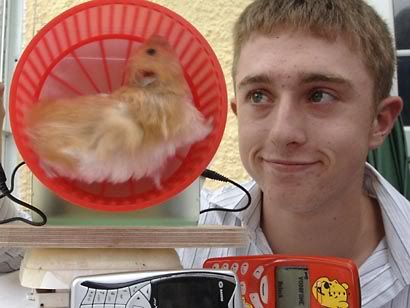Archives for March 2009
How Pet Owners Go Green

Above: Peter Ash, of Lawford, Somerset has his hamster (Elvis) recharge his cell phone off grid.
Are you and your pets going green?
Peter Ash had a great idea on going green with his hamster Elvis. Too bad it didn’t make the grade, so to speak, because his project was only considered average (he got a “C” for the project).
There are a lot of ways you can go green and take steps to become an eco-friendly pet owner but this trend seems to be lagging when it comes to the homes of many pet owners…so I thought I would share a few tips on how to go green.
- Leash Up Don’t Let Loose
When it comes to keeping pets indoors (or under control when out in public) many pet owners fail. On first glance it doesn’t seem like this would be a problem but it is.
Keeping pets in (or under control out in public) actually helps protect wildlife from habitat disturbances, disease, and predation.
This is a big issue up in San Francisco where there is a dog war over the habitat disturbances of wild animals and dogs unleashed upon the area.
Outdoor feline adventures also contribute to the millions of birds killed annually by domestic cats.
- Say No to Junk Foods
Animal by-products (low grade waste from dead, dying, diseased, or disabled animals) are used in many pet foods.
You are what you eat takes on a different meaning if you give it a little thought.
Why would you feed your pet foods that are not fit for human consumption?
Nutrition is important to disease resistance and for maintaining health–which will ultimately help you save on vet bills.
Natural and organic pet foods are better for the environment and our pets.
Consider supporting sustainable agriculture and humanely framed foods that don’t contain hormones and are minimally processed–it really is the way to go.
Also avoid pesticides, hormones, antibiotics, artificial preservatives, artificial ingredients, and genetically engineered ingredients.
- Scoop That Poop!
Cleaning up after your pet prevents the transmission of parasites and other diseases through the environment or the water table.
Biodegradable poop bags or composting with something like the Doggie Dooley are better options than using plastic bags that stay in the landfills for eons.
Cat owners are also encouraged to move away from clay litter because the clay is strip mined–which is not earth friendly.
Try soy, wheat, or some of the other natural cat litters on the market.
Don’t forget that clay litters contain silca dust or sodium bentonite–both can create problems for your kitty.
- Recycled Goods
Get crafty by making toys with recycled materials or by purchasing earth friendly toys supports sustainable manufacturers.
- Go Natural
Natural products & cleaning aids are safer for your pets, your family, and the environment. Contrary to popular belief, non-toxic shampoos and gentle cleaning aids get the job done just as well as those containing toxic chemicals.
- Get Crafty
Grow your own–catnip or cat grass.
Growing veggies is a great way to add good foods to your pet’s food bowl and there are many herbs can be used to make natural pest control products.
Don’t forget that you can make toys from yarn or fabrics.
- Add your How to Go Green Pet Tips below!

